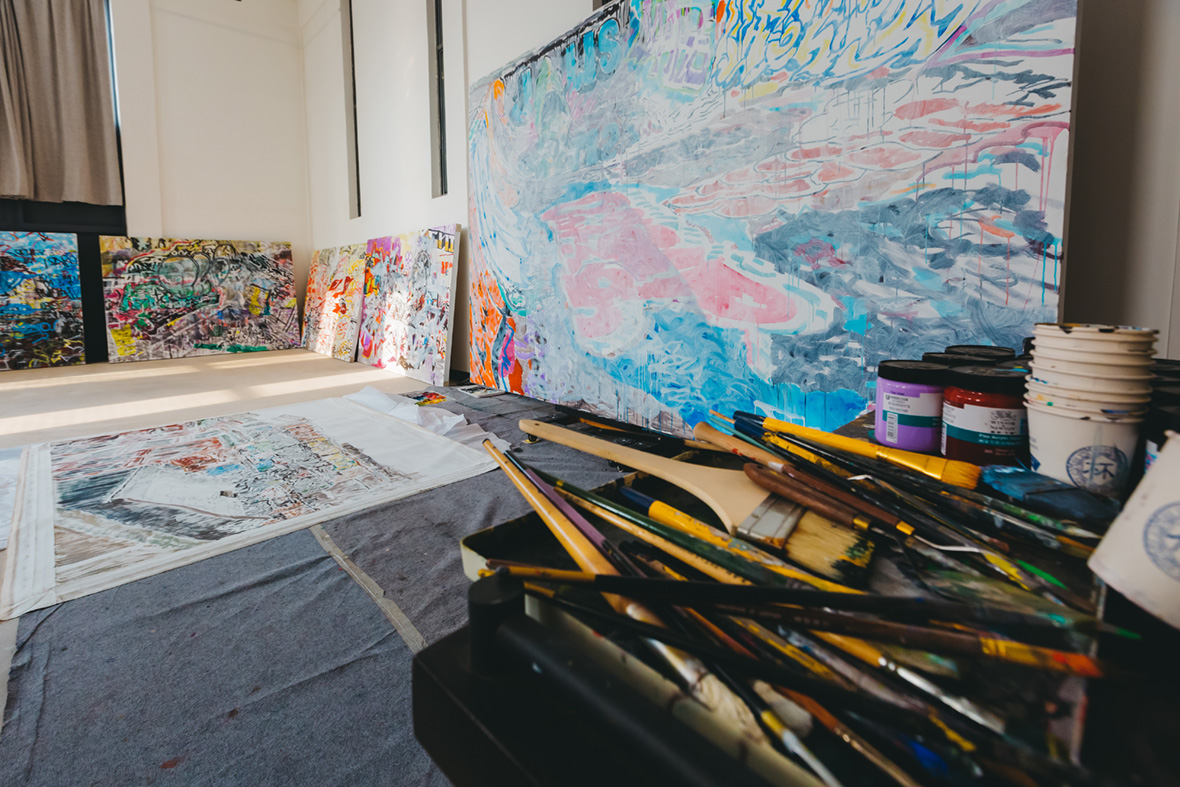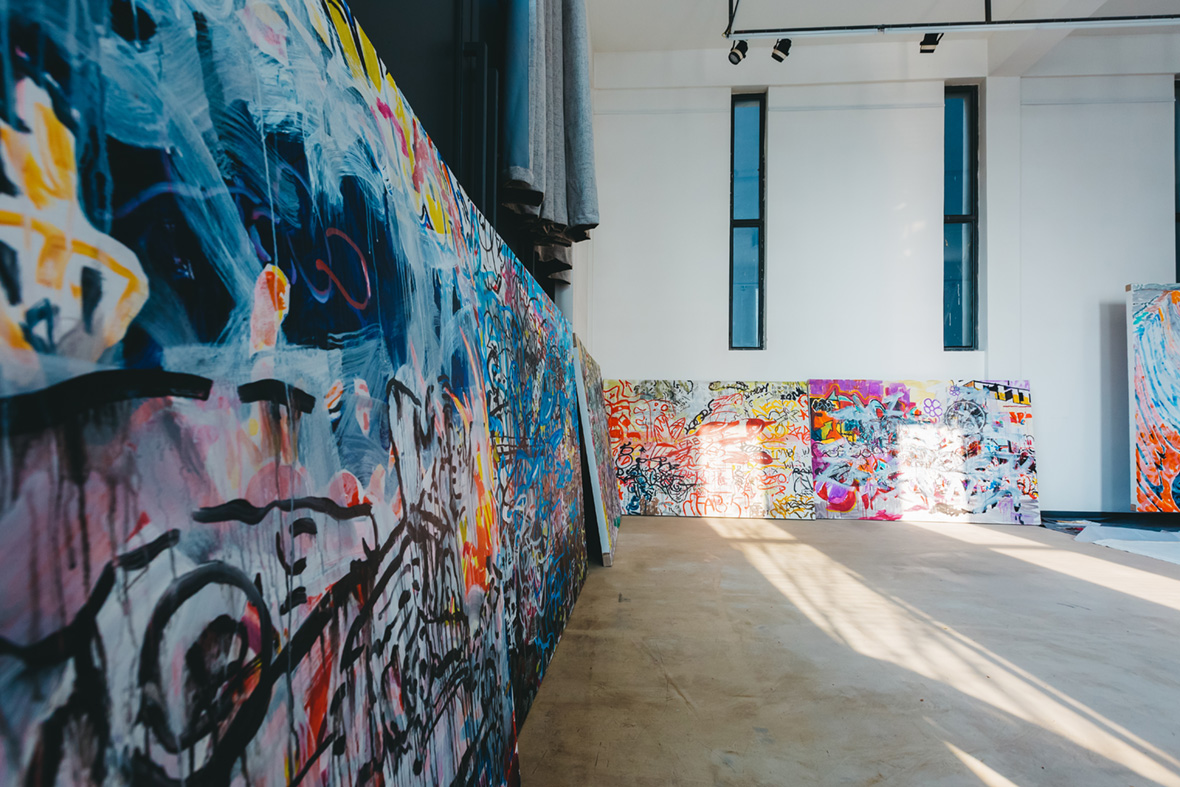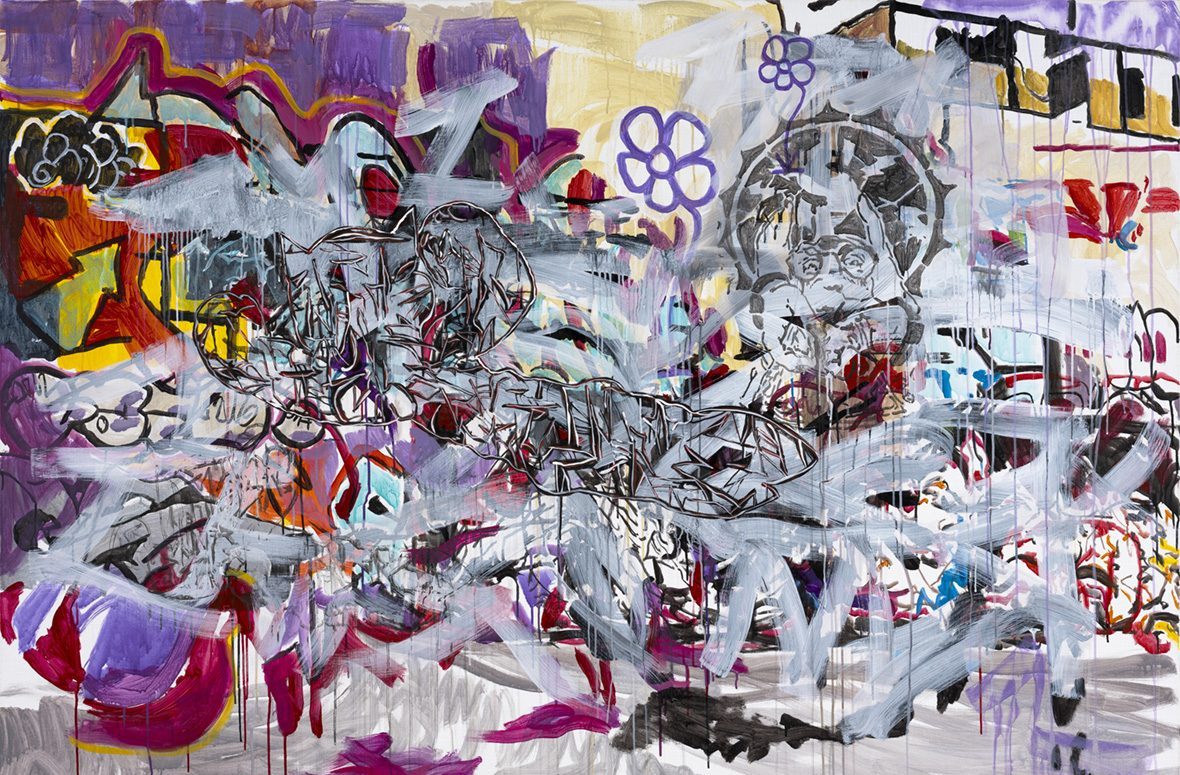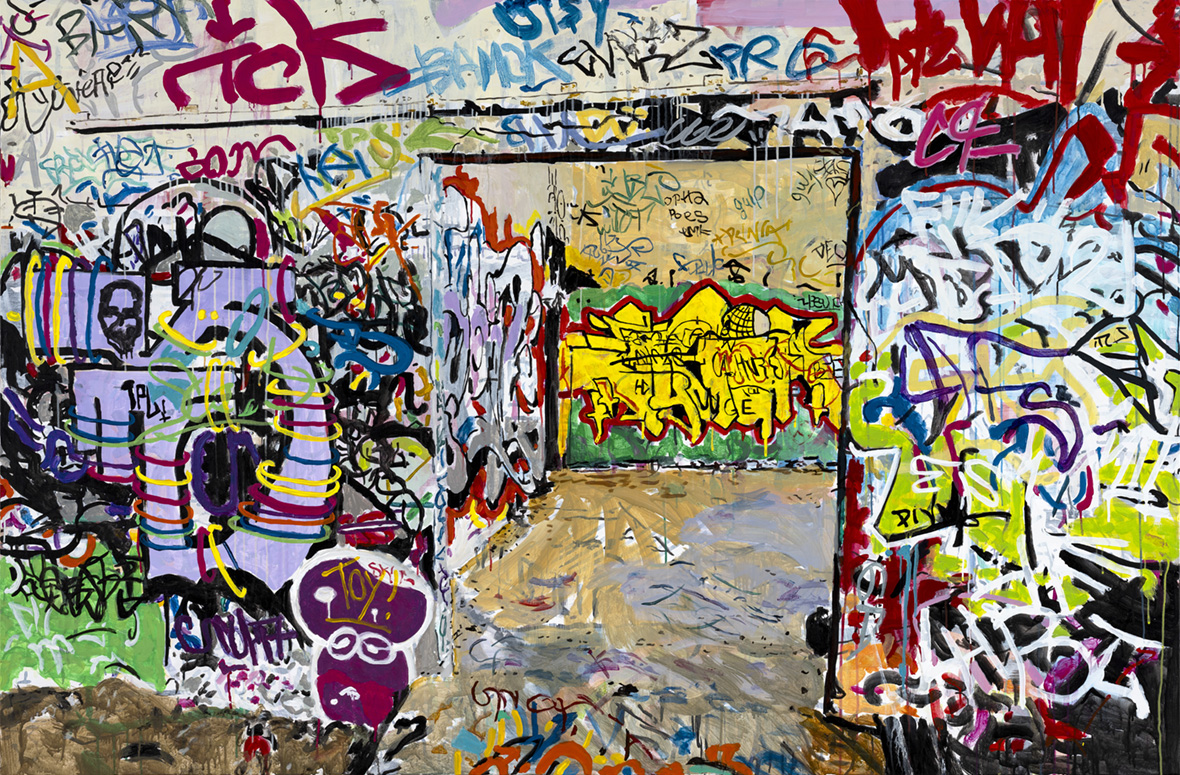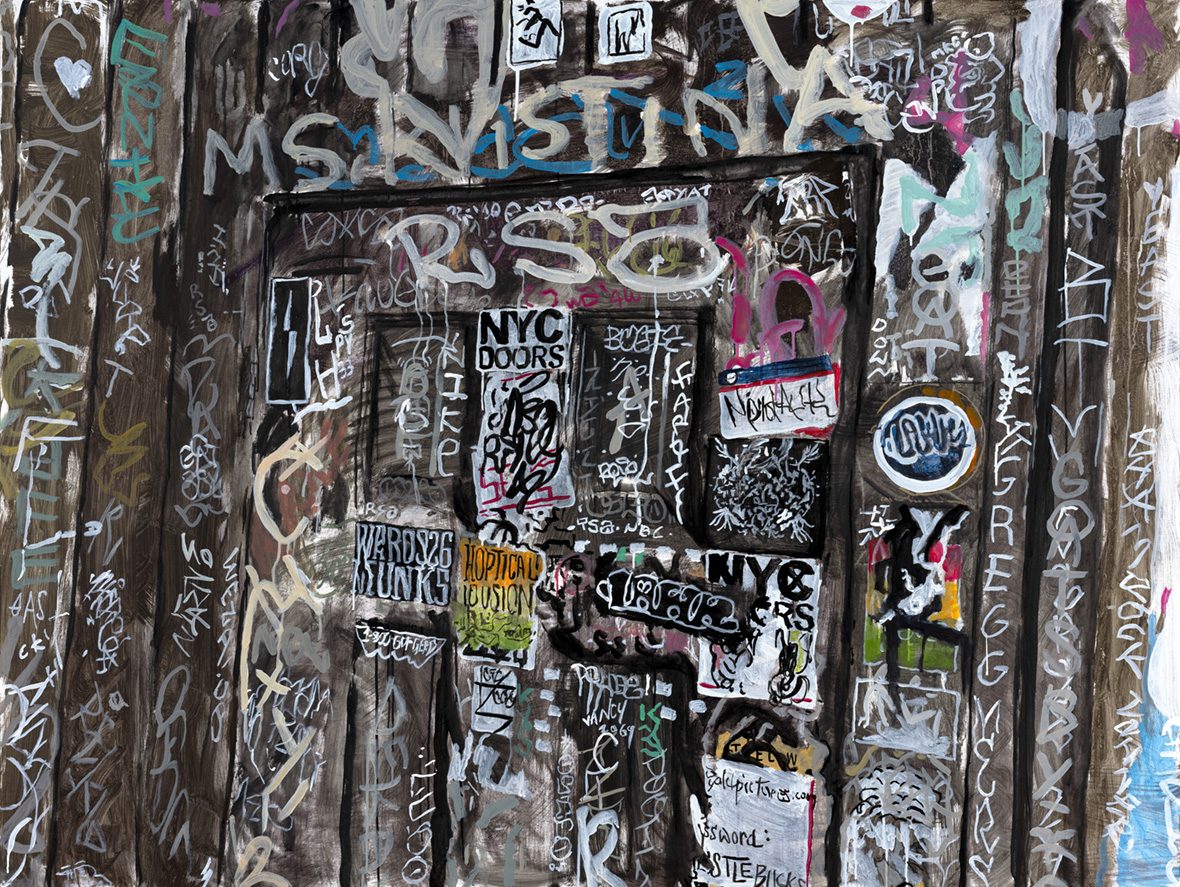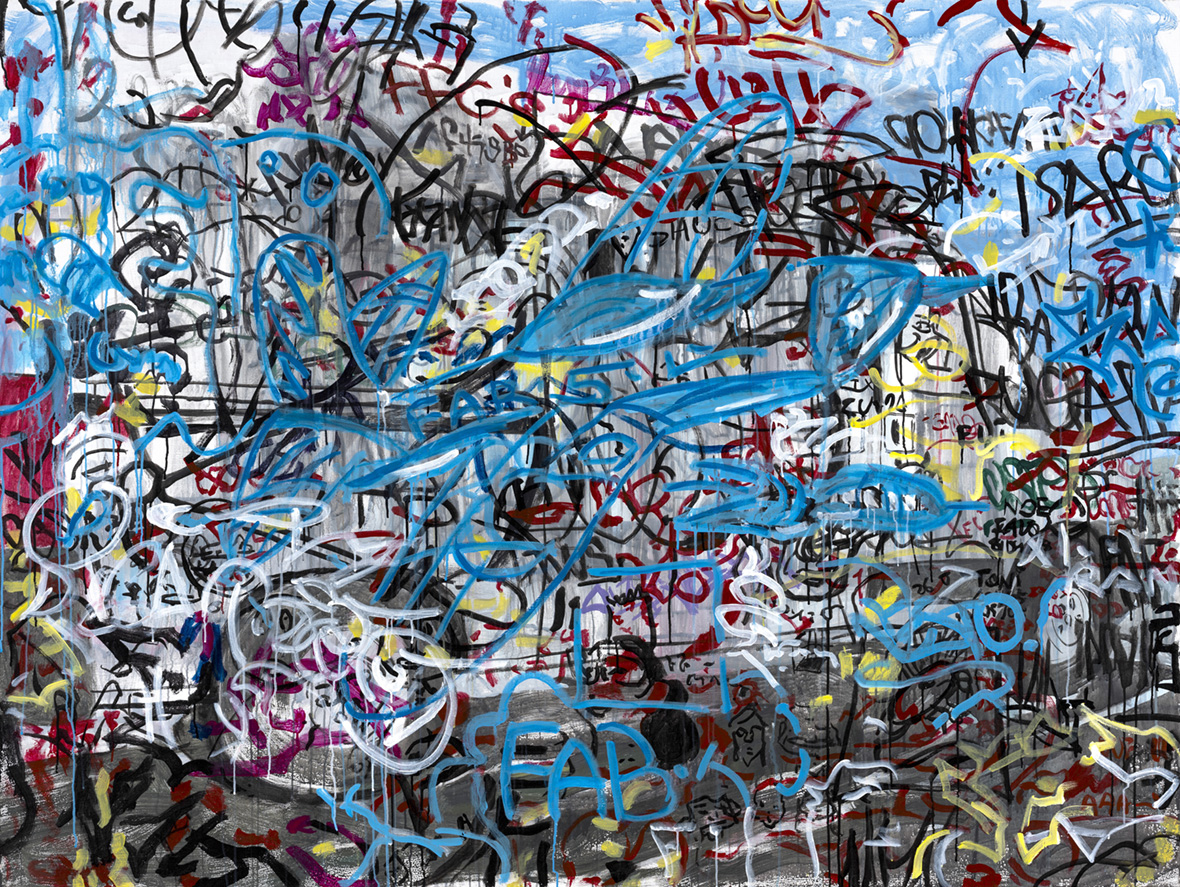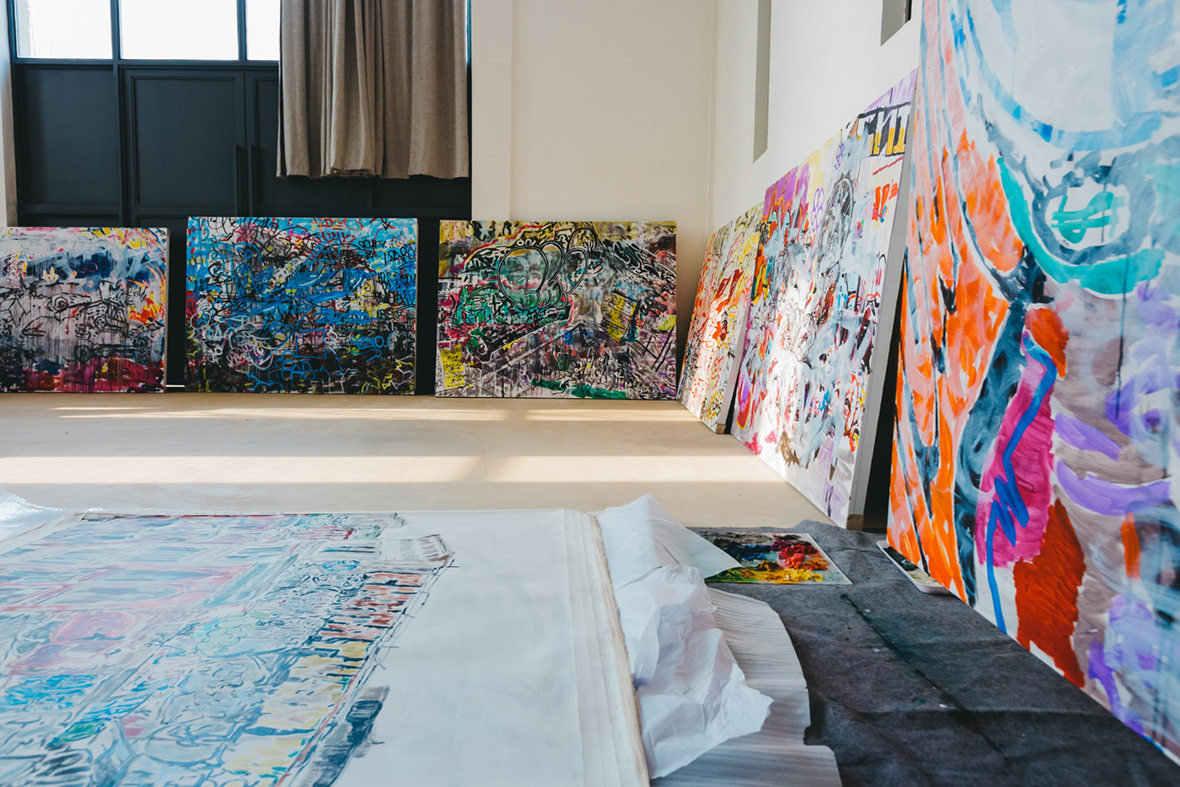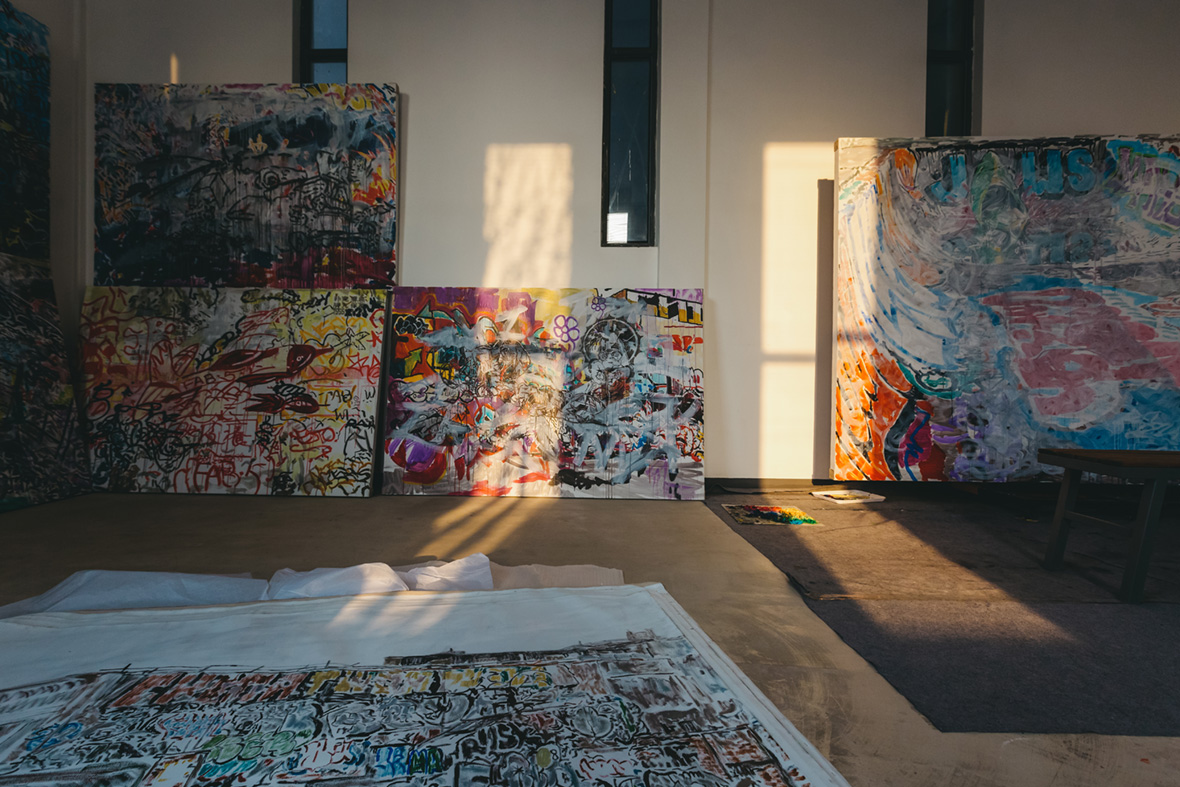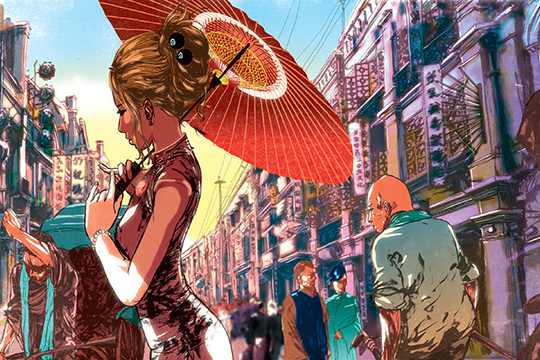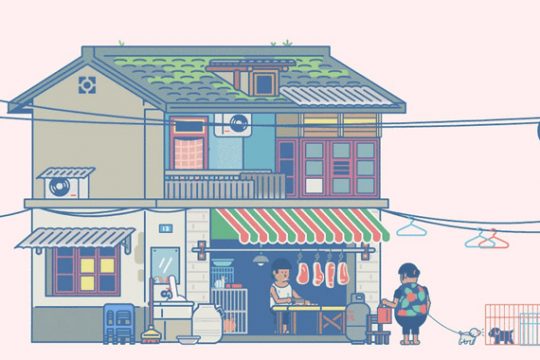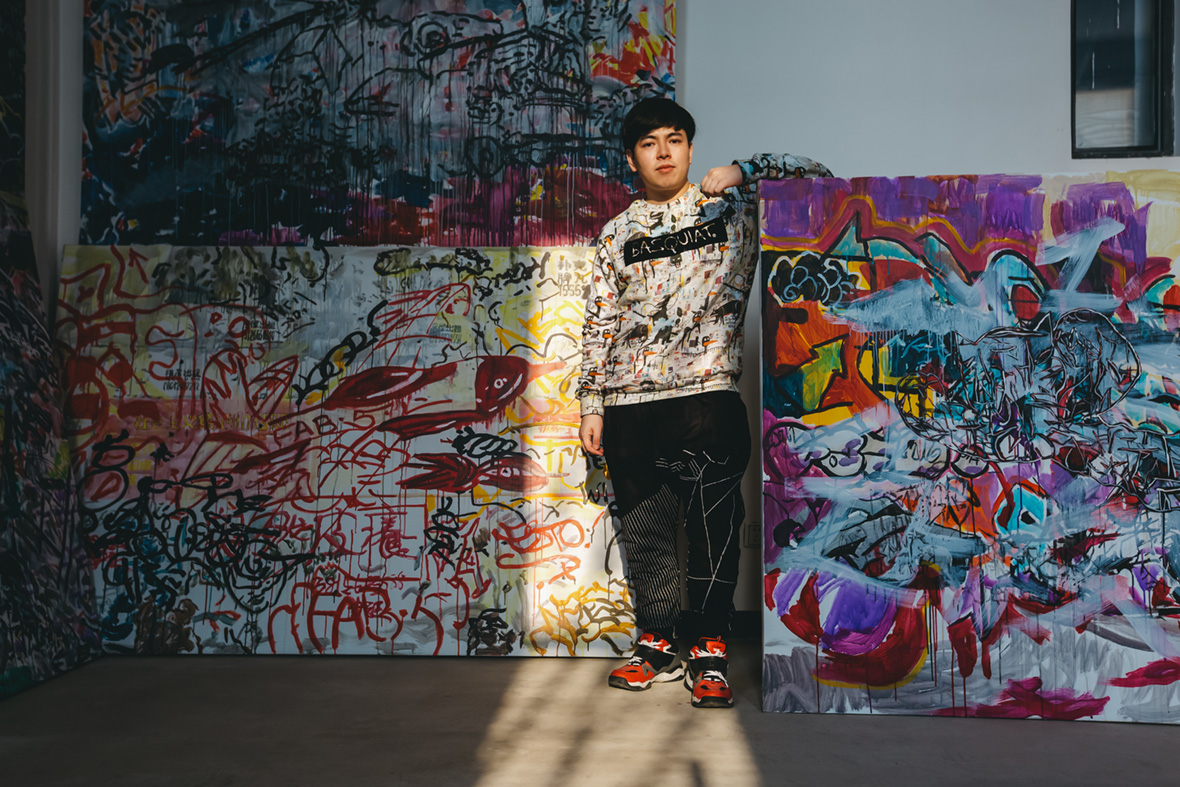
Sometimes artists’ own stories show through in their art. Chen Xuanrong is a Beijing-based artist who uses acrylic paint to create graffiti-like works on huge canvases. The result is a vigorous fusion of styles and techniques that tells the story of an artist who, though raised in the art world, struggled for years to find his place there.
Born in 1991 to a family of artists, Chen faced an unusual kind of parental pressure for success. His mother was a dance teacher, while his father, Chen Zhiguang, was a prominent sculptor who exhibited at notable galleries around the world and became known as the “King of Ants” for his gigantic sculptures of these insects.
有时候,艺术家的故事会通过他们的艺术展现出来。陈轩荣是一位居住在北京的艺术家,擅长在巨大的画布上使用丙烯颜料创造出类似涂鸦的作品。他的创作风格与技巧兼具,之中还隐隐道出一个故事——关于一个在艺术世界中成长、却挣扎着寻找定位的艺术家。
于1991年出生在一个艺术世家,陈轩荣从小面对着一种来自父母、关于追求成功不同于寻常的压力。他的母亲是一名舞蹈老师,而父亲陈志光是一位杰出的雕塑家,曾经在世界各地的著名画廊展出,并因其巨大的昆虫雕塑,被称为“蚂蚁之王”。
Growing up in this environment, Chen started studying art in high school. He admits that it took a few years for him to actually enjoy it. “I didn’t really like art at first, but as I painted and made some progress, it started to grow on me,” he recalls. At first, his motivation was merely to pass his exams to get into a good art school, which he did: he earned a spot studying printmaking at the prestigious Central Academy of Fine Arts in Beijing. While there, he won several art prizes, which pleased his parents immensely.
After graduation, Chen traveled to New York City to immerse himself in the art world. He wanted to see the works of great masters that hang on the walls of the city’s museums, particularly Velázquez and Rubens. All throughout his school years, his books, teachers, and classmates held up these painters as paragons of artistic expression. Xuanrong repeatedly visited the same institutions, studying the masterpieces intently and taking photos to continue to analyze them back in his hotel room. “After two weeks I felt sick of all these masters,” he recalls. Something wasn’t quite right.
在这种环境中长大,陈轩荣在高中开始学习艺术。他承认是在过几年后才真正享受它。“起初我不喜欢艺术,但是当我画画获得一些进展时,我就渐渐喜欢上它了。”他回忆道。一开始,他的动机仅仅是通过考试进入一所好的艺术学校,然而他做到了:他在北京著名的中央美术学院学习版画。在那里他先后赢得了几个奖项,这让他的父母非常高兴。
毕业后,陈轩荣前往纽约,将自己沉浸在艺术世界中。他的愿望是看到挂在博物馆墙壁上那些伟大大师的作品真迹,尤其是维拉斯奎兹(Velázquez)和鲁本斯(Rubens)。在校期间,所有教科书、老师和同学都把这些画家视为艺术表达的典范。陈轩荣多次访问同一间博物馆,专心研读这些杰作,拍下照片回到酒店房间继续研究。“两周后,我却对这些大师作品感到厌倦了。”他回忆道。事情,开始有点不太对劲。
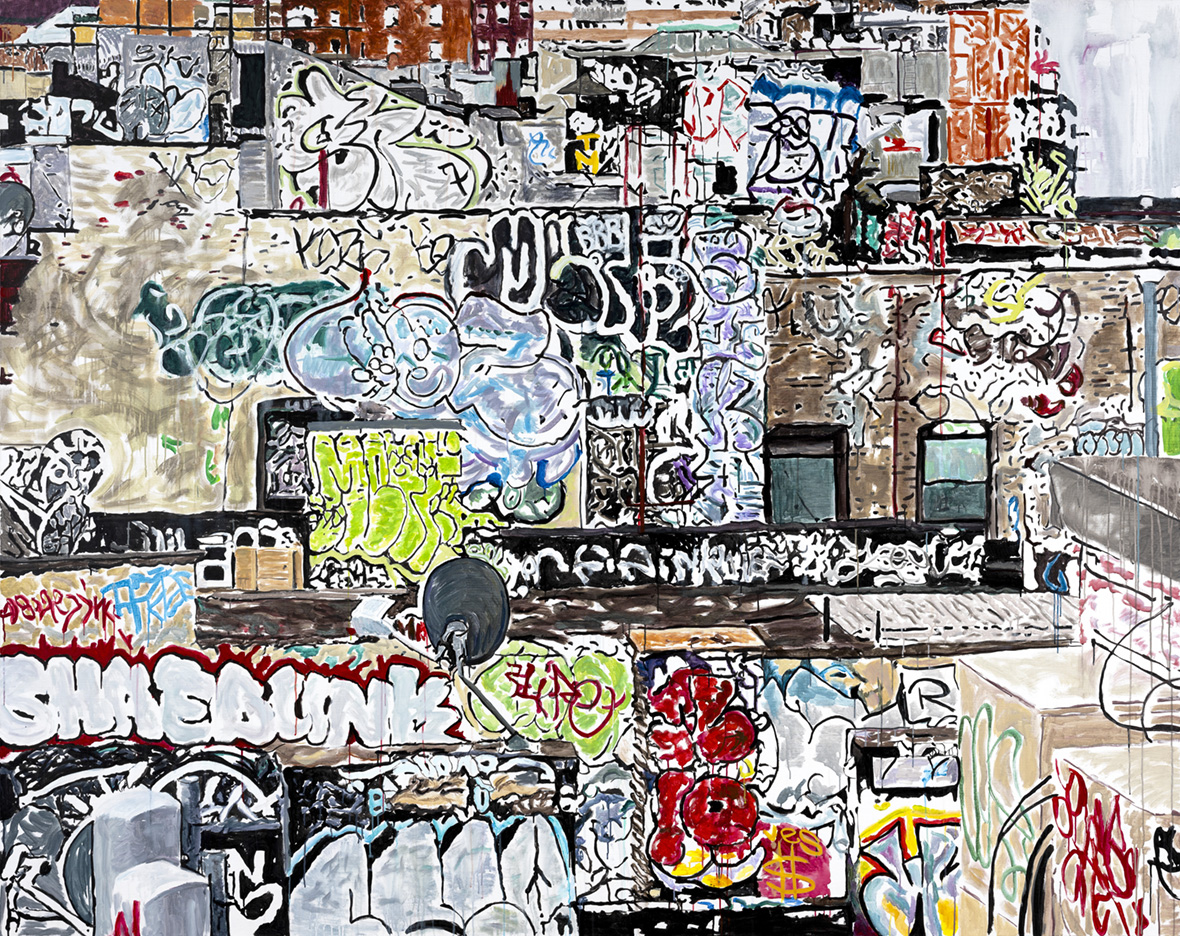
As it turned out, Chen’s hotel was located in Queens, a district with a rich tradition of street art. On his commute, he’d take the 7 train, which runs above ground for much of the way, revealing different views of the city. Bit by bit, he started noticing how several buildings were covered with stunning graffiti, creating striking urban compositions. While exploring Queens, he visited 5 Pointz, an abandoned factory complex that, until its demolition in 2014, was a graffiti Mecca. “When I first got there I was shocked. The colors, the lines . . . none of the old masters used simple lines and pure colors like that.” It was a defining moment, and his attention began to drift away from the walls of the museums to the walls on the streets around him.
陈轩荣的酒店位在皇后区,这是一个富含街头艺术文化的街区。他通勤时经常乘坐地铁7号线,运行路线大部分都在地上,可以看到城市中各种不同的样貌。他开始注意到那些被涂鸦覆盖的建筑物,是如何勾勒出令人惊奇的都市景色。在探索皇后区时,他参观了被称为“涂鸦圣地”的 5 Pointz,这是一个废弃的工厂集合地,直到2014年被拆除。“当我第一次到那里时,我感到好震惊。这些颜色、线条… 没有一个大师画家使用过这样简单的线条和纯粹的颜色。”这是一个决定性的时刻,他的注意力开始从博物馆的展示墙,转移到他周围街道的涂鸦墙上。
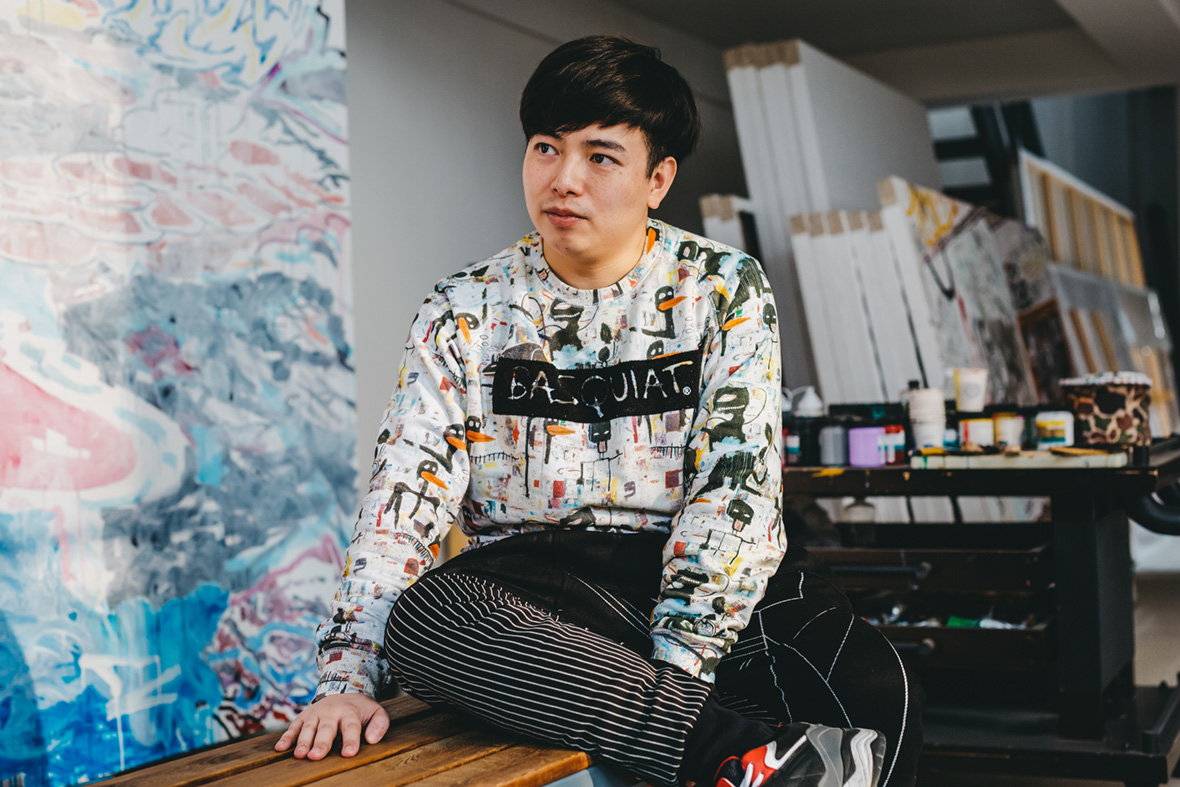
Chen started to absorb street elements and combine them with what he’d learned in school. He began making paintings of the urban environment: walls, alleys, public toilets, abandoned train wagons, and empty pools, all covered in graffiti. Taking works created with spray cans and markers and reproducing them in acrylic on canvas on a large scale—his works are up to three meters wide—became his signature. He now has over 50 pieces that relate to each other as if they came from different sites in the same“graffiti town,” though they’re taken from locations all around the globe.
When he travels, Chen rides the metro and gets out at random stations to explore, hoping to find graffiti art. He constantly takes pictures to have enough material to work with when he gets back to his studio in Beijing. He also looks for interesting locations online, particularly on Instagram. When he reaches a location he’s only seen online, it often look completely different. Yet it’s never a disappointment. “I like how graffiti art changes frequently, how it gets dirty—these are the effects of time,” he says. In his own paintings, he also uses multiple layers, showing old graffiti covered by new. “One of my paintings was shown in an exhibition in Shanghai, and when it was returned to me, I felt the urge to cover it with another layer.”
陈轩荣开始吸收来自街头的创作养分,并与他在学校所学的东西结合起来。他开始画下那些覆盖着涂鸦的城市景观:墙壁、小巷、公共厕所、废弃的火车车厢和空荡荡的游泳池。把这些用喷漆罐和马克笔创作的作品,重现在大规模的帆布上——他的作品通常宽达三米,成为他为人所知的标志。他现在有超过50件作品,相互关联,仿佛它们都出自同一个“涂鸦小镇”。不过,这些作品都取材自世界各地。
当他旅行时,他会乘坐地铁,在随机一站下车去探索城市,希望能找到涂鸦艺术。他会拍摄许多照片,确保回到北京的工作室时手上会有足够的素材。他也会在网上寻找有趣的地点,特别是在 Instagram 上。当他真正去到当地,现实往往看起来不太一样,但这种落差并不会让他感到失望。“我喜欢涂鸦艺术的变幻无常,它如何变脏,如何受到时间的影响。”他说。他的画作通常是多层次的,展示了旧的涂鸦被新的覆盖。“有一次,我的一幅画作在上海的展览中展出,当它被归还给我时,我马上感觉到一股冲动想用另一层画盖掉它。”
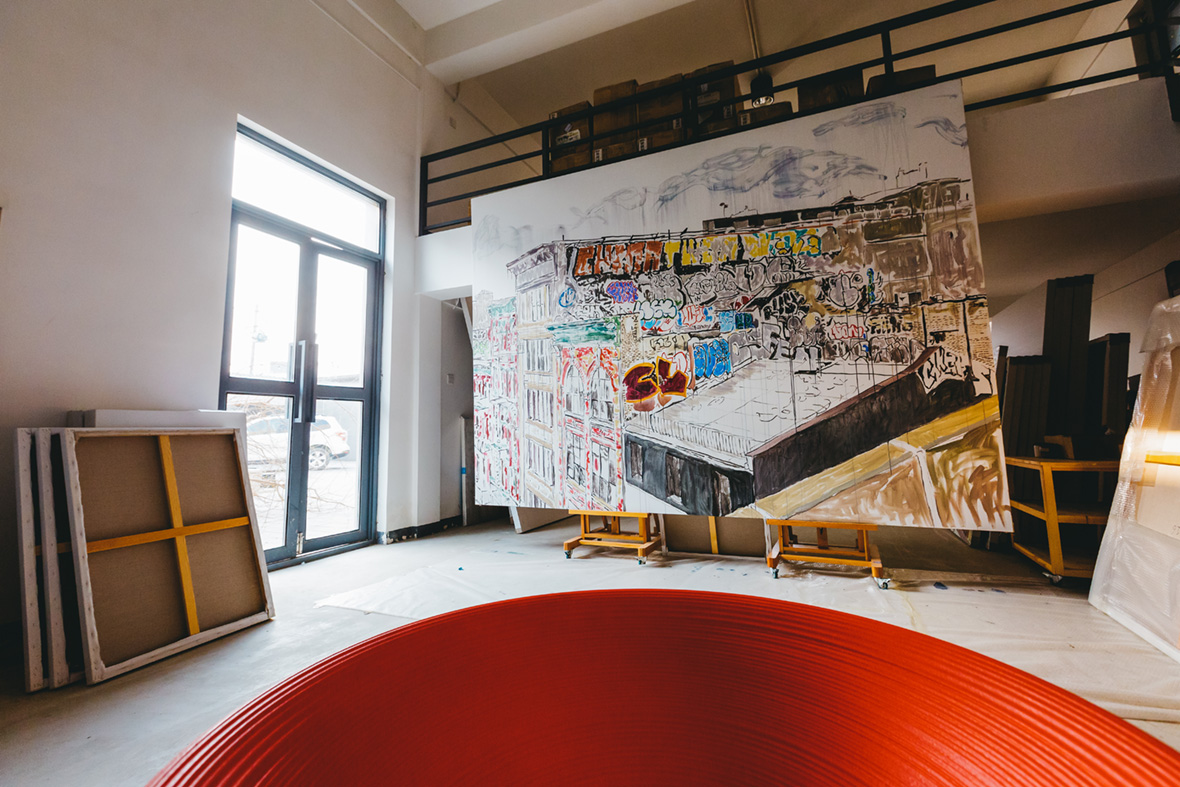
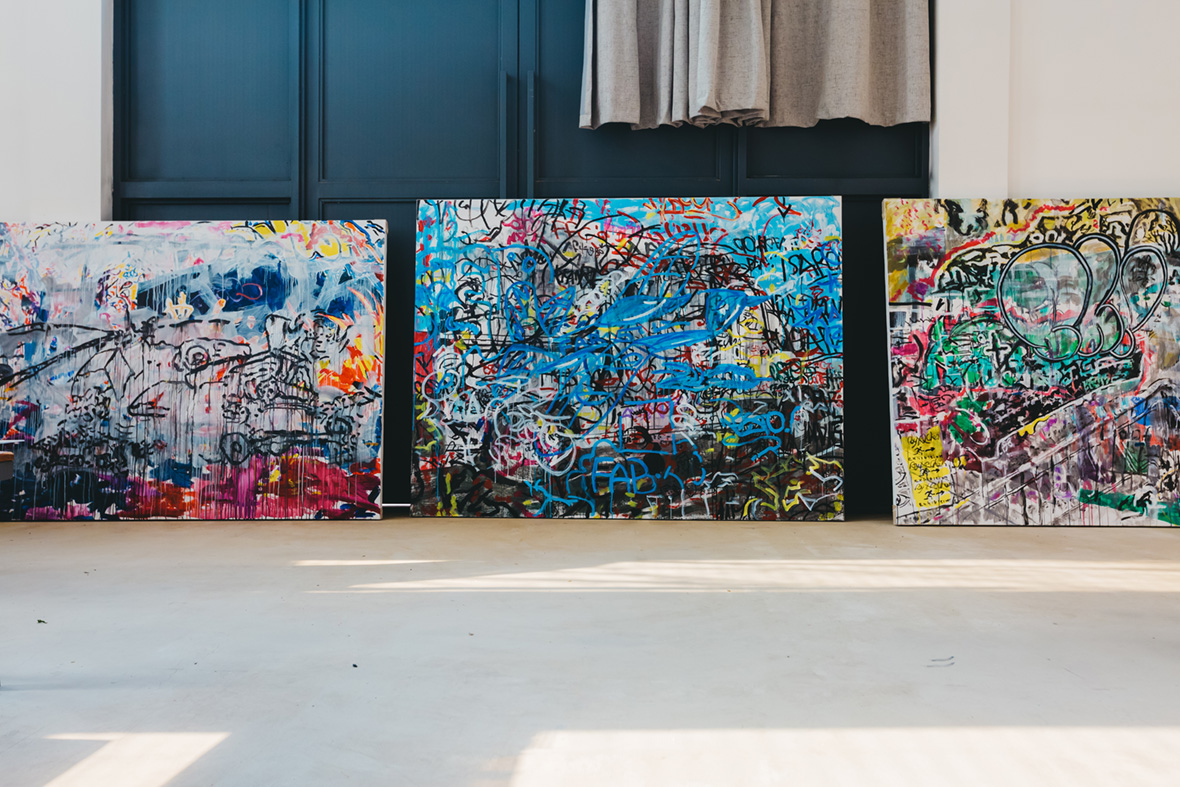
Chen likes to explore areas with graffiti when nobody is there, so that he can observe them properly. “I enjoy the feeling of having the entire place for myself. There’s a strange feeling of mystery,” he explains. He never portrays people in his works: the canvases are populated exclusively by the remains of the scribblings, stickers, and tags left there over time by different people, culminating in a grand chaotic montage.
Human figures would distort what he seeks to portray: an urban landscape of concrete and brick and spray paint. Chen’s works hang on the walls of museums, just like the works of the masters he was compelled to study. Bridging the gap between graffiti and galleries, he’s staked out a place in the art world that’s distinctively his.
To keep up to date with upcoming exhibitions or works from Chen Xuanrong, visit Art+ Shanghai Gallery.
陈轩荣特别喜欢在四下无人的时候探索这些涂鸦,才能够适当地观察它们的全貌。“我喜欢这种自己拥有整个地方的感觉,有一种奇怪的神秘感。”他解释道。他也从不在他的作品中描绘人物,因为这并不是他想要捕捉的东西——城市中的混凝土、砖墙和喷漆才是。
最终,画布完全被由不同的人随着时间留在那里的涂鸦、贴纸、和标记的遗迹所填满,形成一个万花筒般混乱斑斓的巨型蒙太奇。陈轩荣的作品挂在博物馆的墙上,就像当初他被迫学习的那些大师作品一样。作为牵系起涂鸦和画廊之间的桥梁,他在艺术世界中占据了一个与众不同的地位。
想持续关注陈轩荣的展览和作品信息,可点击浏览艺术+上海画廊官网。
Like our stories? Follow us on Facebook and Instagram.
Contributor: Tomas Pinheiro
Photographer: Irina Kovalchuk
Translation: Yang Yixuan
Additional Images Courtesy of Chen Xuanrong

